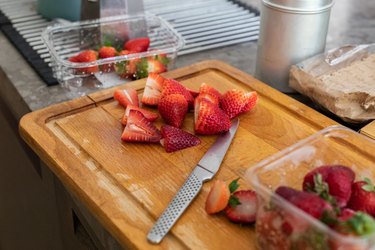
You need to make some adjustments to your diet when you have diverticulitis. While not all fruits may be off the table, you might need to steer clear of strawberries for a little while.
Diverticulitis is a complication that can occur from diverticulosis, a condition marked by small pouches or sacs that push outward through weak spots in the colon. When a pouch becomes infected or inflamed, it's called diverticulitis, which can cause sudden abdominal pain (usually lower left side abdominal pain) as well as nausea or vomiting, diarrhea or constipation, fever or chills, according to the National Institute of Diabetes and Digestive and Kidney Diseases (NIDDK). Symptoms might be mild at first but tend to get worse over the course of a few days.
Video of the Day
Video of the Day
Sometimes a diverticulitis flareup can be managed at home by temporarily changing your diet. Here's the lowdown on what to do, including when it's OK to have strawberries
Are Strawberries Bad for Diverticulitis?
It's best to avoid strawberries during an active diverticulitis flare. To help your colon heal, you'll need to follow a clear liquid diet for a few days followed by a low-fiber diet until your symptoms are completely gone, says Elena Ivanina, DO, MPH, Director of Neurogastroenterology and Motility at Lenox Hill Hospital in New York.
Strawberries are relatively high in fiber, with about 3 grams per cup, according to the USDA.
But it's a good idea to add the fruit back into your diet once your doctor says your diverticulitis has fully healed. In other words, you can eat strawberries when you have diverticulosis, and they're a good choice, too. A fiber-rich diet can actually reduce your risk for future diverticulitis flares, according to the NIDDK.
"Fiber helps prevent constipation, which decreases pressure on the colon. This may help prevent diverticulitis episodes," Dr. Ivanina says.
The Dietary Guidelines for Americans recommend adults get somewhere between 25 and 38 grams of fiber per day, or about 14 grams of fiber for every 1,000 calories you eat.
Which Fruits Should You Avoid With Diverticulitis?
Fruit doesn't have to be entirely off-limits with diverticulitis once your doctor has cleared you to begin eating solids again. But because fruit tends to be fiber-rich, you'll need to be careful about which ones you eat.
High-fiber fruits like berries, fruit with skin and dried fruits are usually best avoided during a flare, Dr. Ivanina says.
As for which fruits might be OK? You're better off sticking with low-fiber options that have had their skin removed, like applesauce, ripe bananas, canned peaches or pears and soft, ripe cantaloupe or honeydew, per the Cleveland Clinic. "These fruits are easier to digest," Dr. Ivanina says.
Keep in mind, though, that fruits don't "trigger" diverticulitis. You can enjoy fruit — including strawberries — when you have diverticulosis without worrying that it will cause a diverticulitis flareup.
According to the Mayo Clinic, risk factors for diverticulitis include aging, obesity, smoking, lack of exercise, certain medications (such as steroids, opioids and NSAIDs) and a diet high in animal fat and low in fiber.
How to Adjust Your Diet When You Have Diverticulitis
Recovering from diverticulitis starts with following a clear liquid diet for several days to minimize irritation in your GI tract and give your bowel a chance to rest and heal, Dr. Ivanina says.
According to the Mayo Clinic, clear liquids include:
- Broth
- Fruit juice without pulp, like apple juice
- Ice chips
- Ice pops without pulp or fruit bits
- Gelatin
- Water
- Coffee or tea without cream
Your symptoms should start to ease up within a few days. When that happens, your doctor will have you ease back into solids by eating low-fiber foods, limiting your overall fiber intake to about 10 to 15 grams per day until your symptoms have completely stopped.
"A low-fiber diet does not activate the colon to contract and produce bowel movements as much as a high-fiber diet does," Dr. Ivanina explains.
While on a low-fiber diet, you'll be advised to steer clear of highly fibrous foods like strawberries.
Per the Mayo Clinic, low-fiber foods might include:
- Canned or cooked fruit without skin or seeds
- Canned or cooked vegetables without skin, like carrots, green beans or potatoes
- Eggs
- Poultry
- Seafood
- White bread
- White rice or pasta
- Milk, cheese and yogurt
Once your symptoms have completely gone away, you can go back to eating a regular diet. Try to gradually increase your intake of high-fiber foods (including strawberries) while drinking plenty of water.
- Cleveland Clinic: "What Foods Should You Eat — and Avoid — on a Diverticulitis Diet?"
- Mayo Clinic: "Diverticulitis Diet"
- National Institute of Diabetes and Digestive and Kidney Diseases: "Symptoms & Causes of Diverticular Disease"
- USDA FoodData Central: "Strawberries, raw"
- Dietary Guidelines for Americans, 2020-2025 and Online Materials
- Mayo Clinic: "Diverticulitis"
- Cleveland Clinic: Diverticulosis and Diverticulitis
- MedlinePlus: Diverticulosis and Diverticulitis
Was this article helpful?
150 Characters Max
0/150
Thank you for sharing!
Thank you for your feedback!
Is this an emergency? If you are experiencing serious medical symptoms, please see the National Library of Medicine’s list of signs you need emergency medical attention or call 911.